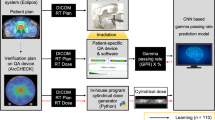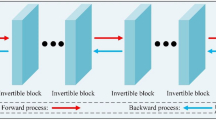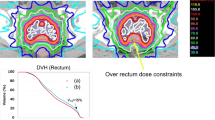Abstract
Measurement-based verification is impossible for the patient-specific quality assurance (QA) of online adaptive magnetic resonance imaging-guided radiotherapy (oMRgRT) because the patient remains on the couch throughout the session. We assessed a deep learning (DL) system for oMRgRT to predict the gamma passing rate (GPR). This study collected 125 verification plans [reference plan (RP), 100; adapted plan (AP), 25] from patients with prostate cancer treated using Elekta Unity. Based on our previous study, we employed a convolutional neural network that predicted the GPRs of nine pairs of gamma criteria from 1%/1 mm to 3%/3 mm. First, we trained and tested the DL model using RPs (n = 75 and n = 25 for training and testing, respectively) for its optimization. Second, we tested the GPR prediction accuracy using APs to determine whether the DL model could be applied to APs. The mean absolute error (MAE) and correlation coefficient (r) of the RPs were 1.22 ± 0.27% and 0.29 ± 0.10 in 3%/2 mm, 1.35 ± 0.16% and 0.37 ± 0.15 in 2%/2 mm, and 3.62 ± 0.55% and 0.32 ± 0.14 in 1%/1 mm, respectively. The MAE and r of the APs were 1.13 ± 0.33% and 0.35 ± 0.22 in 3%/2 mm, 1.68 ± 0.47% and 0.30 ± 0.11 in 2%/2 mm, and 5.08 ± 0.29% and 0.15 ± 0.10 in 1%/1 mm, respectively. The time cost was within 3 s for the prediction. The results suggest the DL-based model has the potential for rapid GPR prediction in Elekta Unity.




Similar content being viewed by others
Data availability
The data that support the findings of this study are available from the corresponding author upon reasonable request.
References
Lagendijk JJ, Raaymakers BW, Raaijmakers AJ, et al. MRI/linac integration. Radiother Oncol. 2008;86(1):25–9.
Winkel D, Bol GH, Kroon PS, et al. Adaptive radiotherapy: the elekta unity MR-linac concept. Clin Transl Radiat Oncol. 2019;18:54–9.
Sonke JJ, Aznar M, Rasch C. Adaptive radiotherapy for anatomical changes. Semin Radiat Oncol. 2019;29(3):245–57.
Ezzell GA, Burmeister JW, Dogan N, et al. IMRT commissioning: multiple institution planning and dosimetry comparisons, a report from AAPM task group 119. Med Phys. 2009;36(11):5359–73.
Miften M, Olch A, Mihailidis D, et al. Tolerance limits and methodologies for IMRT measurement-based verification QA: recommendations of AAPM task group no. 218. Med Phys. 2018;45(4):e53–83.
Raaijmakers AJ, Raaymakers BW, Lagendijk JJ. Integrating a MRI scanner with a 6 MV radiotherapy accelerator: dose increase at tissue-air interfaces in a lateral magnetic field due to returning electrons. Phys Med Biol. 2005;50(7):1363–76.
Nachbar M, Mönnich D, Boeke S, et al. Partial breast irradiation with the 1.5 T MR-linac: first patient treatment and analysis of electron return and stream effects. Radiother Oncol. 2020;145:30–5.
Chen GP, Ahunbay E, Li XA. Technical note: development and performance of a software tool for quality assurance of online replanning with a conventional Linac or MR-Linac. Med Phys. 2016;43(4):1713.
Graves SA, Snyder JE, Boczkowski A, et al. Commissioning and performance evaluation of RadCalc for the elekta unity MRI-linac. J Appl Clin Med Phys. 2019;20(12):54–62.
Li Y, Wang B, Ding S, et al. Feasibility of using a commercial collapsed cone dose engine for 1.5T MR-LINAC online independent dose verification. Phys Med. 2020;80:288–96.
Ahmad SB, Sarfehnia A, Paudel MR, et al. Evaluation of a commercial MRI Linac based monte carlo dose calculation algorithm with GEANT4. Med Phys. 2016;43(2):894–907.
Friedel M, Nachbar M, Mönnich D, Dohm O, Thorwarth D. Development and validation of a 1.5 T MR-linac full accelerator head and cryostat model for monte carlo dose simulations. Med Phys. 2019;46(11):5304–13.
Li Y, Ding S, Wang B, Liu H, Huang X, Song T. Extension and validation of a GPU-monte carlo dose engine gDPM for 1.5 T MR-LINAC online independent dose verification. Med Phys. 2021;48(10):6174–83.
Cheng B, Xu Y, Li S, et al. Development and clinical application of a GPU-based monte carlo dose verification module and software for 1.5 T MR-LINAC. Med Phys. 2023;50(5):3172–83.
Interian Y, Rideout V, Kearney VP, et al. Deep nets vs expert designed features in medical physics: an IMRT QA case study. Med Phys. 2018;45(6):2672–80.
Tomori S, Kadoya N, Takayama Y, et al. A deep learning-based prediction model for gamma evaluation in patient-specific quality assurance. Med Phys. 2018. https://doi.org/10.1002/mp.13112.
Tomori S, Kadoya N, Kajikawa T, et al. Systematic method for a deep learning-based prediction model for gamma evaluation in patient-specific quality assurance of volumetric modulated arc therapy. Med Phys. 2021;48(3):1003–18.
Matsuura T, Kawahara D, Saito A, Yamada K, Ozawa S, Nagata Y. A synthesized gamma distribution-based patient-specific VMAT QA using a generative adversarial network. Med Phys. 2023;50(4):2488–98.
Hao Y, Zhang X, Wang J, Zhao T, Sun B. Improvement of IMRT QA prediction using imaging-based neural architecture search. Med Phys. 2022;49(8):5236–43.
Snyder JE, St-Aubin J, Yaddanapudi S, et al. Commissioning of a 1.5T elekta unity MR-linac: a single institution experience. J Appl Clin Med Phys. 2020;21(7):160–72.
Tozuka R, Kadoya N, Tomori S, et al. Improvement of deep learning prediction model in patient-specific QA for VMAT with MLC leaf position map and patient’s dose distribution. J Appl Clin Med Phys. 2023;24(10): e14055.
Simonyan K, Zisserman A. Very deep convolutional networks for large-scale image recognition. 2014:arXiv:1409.1556. https://doi.org/10.48550/arXiv.1409.1556. https://ui.adsabs.harvard.edu/abs/2014arXiv1409.1556S. Accessed 1 Sept 2014.
Quintero P, Benoit D, Cheng Y, Moore C, Beavis A. Machine learning-based predictions of gamma passing rates for virtual specific-plan verification based on modulation maps, monitor unit profiles, and composite dose images. Phys Med Biol. 2022. https://doi.org/10.1088/1361-6560/aca38a.
Reynolds M, Fallone BG, Rathee S. Dose response of selected solid state detectors in applied homogeneous transverse and longitudinal magnetic fields. Med Phys. 2014;41(9): 092103.
Ellefson ST, Culberson WS, Bednarz BP, DeWerd LA, Bayouth JE. An analysis of the ArcCHECK-MR diode array’s performance for ViewRay quality assurance. J Appl Clin Med Phys. 2017;18(4):161–71.
Huang Y, Pi Y, Ma K, et al. Virtual patient-specific quality assurance of IMRT Using UNet++: classification, gamma passing rates prediction, and dose difference prediction. Front Oncol. 2021;11: 700343.
Nelms BE, Zhen H, Tomé WA. Per-beam, planar IMRT QA passing rates do not predict clinically relevant patient dose errors. Med Phys. 2011;38(2):1037–44.
Fredh A, Scherman JB, Fog LS, Munck af Rosenschöld P. Patient QA systems for rotational radiation therapy: a comparative experimental study with intentional errors. Med Phys. 2013;40(3):031716.
Tsekas G, Bol GH, Raaymakers BW, Kontaxis C. DeepDose: a robust deep learning-based dose engine for abdominal tumours in a 1.5 T MRI radiotherapy system. Phys Med Biol. 2021;66(6):065017.
Tsekas G, Bol GH, Raaymakers BW. Robust deep learning-based forward dose calculations for VMAT on the 1.5T MR-linac. Phys Med Biol. 2022;67(22):225020.
Delfs B, Schoenfeld AA, Poppinga D, et al. Magnetic fields are causing small, but significant changes of the radiochromic EBT3 film response to 6 MV photons. Phys Med Biol. 2018;63(3): 035028.
Steinmann A, O’Brien D, Stafford R, et al. Investigation of TLD and EBT3 performance under the presence of 1.5T, 0.35T, and 0T magnetic field strengths in MR/CT visible materials. Med Phys. 2019;46(7):3217–26.
de Vries JHW, Seravalli E, Houweling AC, et al. Characterization of a prototype MR-compatible Delta4 QA system in a 1.5 tesla MR-linac. Phys Med Biol. 2018;63(2):02NT02.
Barten DLJ, Hoffmans D, Palacios MA, Heukelom S, van Battum LJ. Suitability of EBT3 GafChromic film for quality assurance in MR-guided radiotherapy at 0.35 T with and without real-time MR imaging. Phys Med Biol. 2018;63(16):165014.
Desai V, Bayouth J, Smilowitz J, Yadav P. A clinical validation of the MR-compatible delta. J Appl Clin Med Phys. 2021;22(4):82–91.
Author information
Authors and Affiliations
Corresponding author
Ethics declarations
Conflict of interest
Kadoya and Tozuka has AiRato.Inc. stocks. Jingu has been awarded a research grant from Elekta.
Ethical approval
This study was approved by the Research Ethics Committee of Tohoku University Graduate School of Medicine (approval number: 2022-1-220).
Additional information
Publisher's Note
Springer Nature remains neutral with regard to jurisdictional claims in published maps and institutional affiliations.
About this article
Cite this article
Tozuka, R., Kadoya, N., Arai, K. et al. Assessment of the deep learning-based gamma passing rate prediction system for 1.5 T magnetic resonance-guided linear accelerator. Radiol Phys Technol (2024). https://doi.org/10.1007/s12194-024-00800-2
Received:
Revised:
Accepted:
Published:
DOI: https://doi.org/10.1007/s12194-024-00800-2




